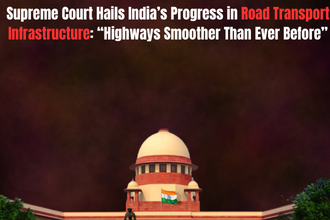In a recent judgment, the Supreme Court of India praised the remarkable improvements in the country’s road transport infrastructure, noting that India has undergone a “quantum leap” from its earlier foundations. The Bench comprising Justice Dipankar Datta and Justice A.G. Masih observed that the nation has significantly transformed travel conditions, enhanced road quality, expanded connectivity, and introduced modern, technology-driven transport services.
The remarks came during the decision of the case U.P. State Road Transport Corporation vs. Kashmiri Lal Batra & Others, where the Court also clarified that private bus operators cannot ply on inter-state routes exclusively reserved for State Road Transport Corporations (SRTCs). However, it was the Court’s commentary on national road progress that drew broad attention, applauding India’s continuous efforts toward better, faster, and more sustainable mobility.
A Quantum Leap in Road Connectivity
The Court highlighted that India has moved far beyond its “humble beginnings” in road travel. Today, thousands of kilometers of highways and expressways connect even remote rural areas to nearby towns and cities, ensuring last-mile connectivity. This expansion has been instrumental for:
- Economic development
- Trade and logistics
- Tourism
- Social mobility
- Emergency accessibility
The improved road network allows both goods and passengers to move more efficiently than ever before, contributing to India’s rapid growth in multiple sectors.
Highways and Expressways: Faster and Smoother Travel
One of the most noteworthy observations of the Supreme Court was the enhancement in road surface quality. The Bench stated that the surface of modern highways and expressways is “smoother than ever before,” reflecting:
- Better use of materials and engineering technology
- High-quality maintenance standards
- Increased accountability in project implementation
Modern expressways such as the Delhi-Meerut Expressway, Mumbai-Pune Expressway, Delhi-Mumbai Expressway, Purvanchal Expressway, and many others have drastically reduced travel time, improving commuter convenience and logistics efficiency.
Comfort Comparable to Global Standards
The Court acknowledged that stage carriage services (public bus transport) have significantly improved in terms of comfort and convenience, now offering facilities comparable to international transport services. Features like:
- Air-conditioned buses
- Comfortable seating
- GPS-integrated tracking
- Smooth travel due to improved road conditions
have elevated the overall travel experience for daily commuters and long-distance travelers alike.
Shift Toward E-Mobility and Sustainable Transportation
In its remarks, the Court emphasized the growing transition to electric vehicles (EVs) across public and private transportation systems. The introduction of electric buses (e-buses) in major cities and intercity routes marks a significant shift towards:
- Reduced carbon emissions
- Lower operating costs
- Cleaner and healthier urban environments
This push aligns with India’s commitment to global sustainability goals and its aspiration to lead in green mobility solutions.
Smart Transportation Through Technology Integration
The Court further acknowledged the rise of smart transportation, where technology plays a central role in improving:
- Efficiency
- Safety
- Passenger convenience
- Fleet management
Key developments include:
| Innovation | Impact |
|---|---|
| Online booking portals | Faster and easier ticketing for passengers |
| Mobile apps with live tracking | Real-time updates on bus location and schedule |
| Digital payment systems | Hassle-free, cashless travel |
| Integrated route management software | Optimized fuel and route efficiency |
The digitalization of SRTCs has also been a “game changer”, bringing greater transparency and competitiveness to public transportation services.
State Road Transport Corporations: Thriving Through Innovation
The Supreme Court noted that several State Road Transport Corporations have shown impressive growth, driven by modernization and technology adoption. While some older buses are still in use, SRTCs have:
- Expanded fleets with modern buses
- Adopted electric and hybrid models
- Upgraded maintenance and safety practices
- Enhanced route and schedule efficiency
This evolution reinforces the public transport sector as a backbone of affordable mobility across India.
Passengers’ Interests Must Remain the Top Priority
Even while applauding progress, the Supreme Court emphasized that the welfare and convenience of passengers must always remain at the center of transport policy decisions. Authorities and operators must continue to ensure:
- Safety on roads
- Affordable fare structures
- Reliable transportation services
- Inclusive access for all demographics, including rural and low-income groups
The Court reminded all stakeholders that infrastructure development is meaningful only when passenger benefits are protected.
Case Context: Private Operators vs. State Corporations
In the underlying case, the Court ruled that:
Private transport companies cannot operate on inter-state routes that are officially reserved for State Road Transport Corporations.
This ruling reinforces the legal authority of SRTCs in regulated transportation zones and prevents unauthorized or overlapping route operations that could disrupt organized public transport systems.
Conclusion
The Supreme Court’s remarks reflect a broader acknowledgment of India’s ongoing progress in transport infrastructure, green mobility, and digital modernization. From smoother expressways to the adoption of electric buses and live tracking apps, India’s road transport system is steadily evolving to meet global standards of efficiency, comfort, and sustainability.
However, the Court’s reminder remains clear: Despite the advancements, the core objective must always be the welfare of passengers and commuters. Continuous improvement, responsible innovation, and people-first policy planning are the keys to ensuring that India’s transportation future remains inclusive, modern, and sustainable.



